
Vitaly
Don't know Hebrew, but need to understand a sign or menu? All you need is your smartphone camera. This article provides simple instructions and the best free apps to help you instantly translate Hebrew text into English from a photo or screenshot.
You find yourself in a bustling market in Tel Aviv, surrounded by bright signs in an unfamiliar language. How can you understand what is written? If you don't know Hebrew, don't panic — just take out your smartphone. Today, photo translation from Hebrew to English solves the problem in a matter of seconds.
In this article, we will explore how to translate text from a photo in Hebrew and review the best apps and online services for this task.
Translating inscriptions from photographs is a tricky business. To ensure accurate results, it is important to consider several points.
Firstly, image quality: the higher the sharpness and lighting, the fewer errors in text recognition. A blurred photo or fancy font on a sign can confuse the algorithm and lead to distortions.
Secondly, text format and language: most services work well with printed text, but may not recognise handwritten or stylised Hebrew.
It is worth remembering that letters are written from right to left – modern translators take this into account automatically.
Finally, even a perfect image doesn’t guarantee a perfect translation. Machine translation can miss nuances of meaning, especially in official documents or complex texts. Don’t be lazy to double-check important details yourself or ask a native speaker if the result is questionable.
Translating from Hebrew to Russian based on an image requires both technical and linguistic accuracy. Follow these simple recommendations to get the best results:
If you follow these rules, even a menu in Hebrew or a road sign will no longer be a mystery.
By the way, most services support popular image formats (JPEG, PNG, and GIF) and even PDF files, so you can translate text from Hebrew to English from an image in almost any convenient format.
We have selected the most reliable tools that can be used to translate from Hebrew to Russian using a photo directly on your smartphone. All of them either have a mobile app for Android and iOS or are accessible via a browser on your phone. Let's take a look at their features – supported formats, limitations, and what makes each service convenient.
To compare the quality of translation, let's use the same photo to test all services. This is a sign at a bus stop.
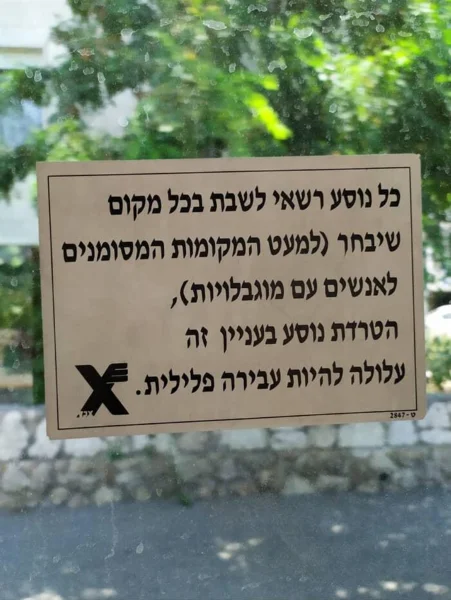
Sign at a bus stop in Hebrew
The Google Translate app can instantly translate text directly in the camera. You can point the camera at a sign or menu, and the translation will immediately appear on top of the image. The service supports offline mode (you need to download the language pack, including Hebrew, in advance) and automatically detects the language in the image. To translate a photo you have already taken, select it from the app's gallery.
It is completely free to use and has no limits on the number of requests. Thanks to cloud technologies, Google provides fairly accurate translations, although there may be some errors with idioms and context. However, simple texts – signs, price tags, announcements – are translated instantly and correctly.
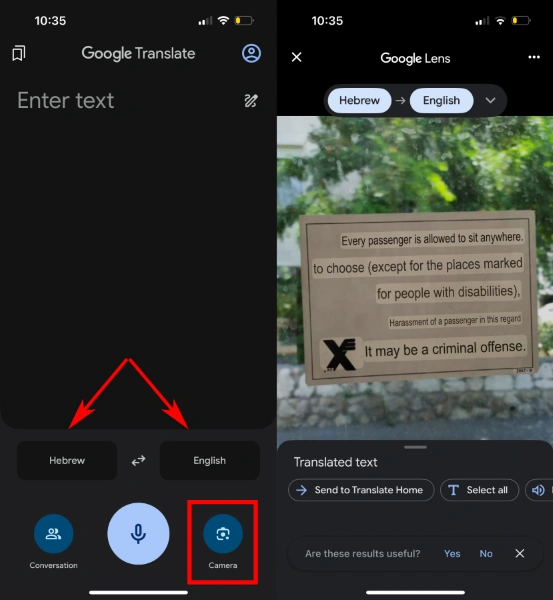
Translation of a sign at a bus stop in Hebrew using Google Translate
The mobile app has a camera mode: just point your smartphone at the text and the translation will appear on the screen. If you don't want to install the app, the web version will do – the Yandex.Translate website has a “Images” tab where you can upload photos for translation.
The service is free and does not require registration. Yandex automatically detects the language of the text and, when connected to the internet, provides a translation.
One of Yandex's strengths is its high-quality Russian translation, which takes context into account, as Russian is the native language of this neural network. However, there is no offline mode for photos, so you will need to have an internet connection.
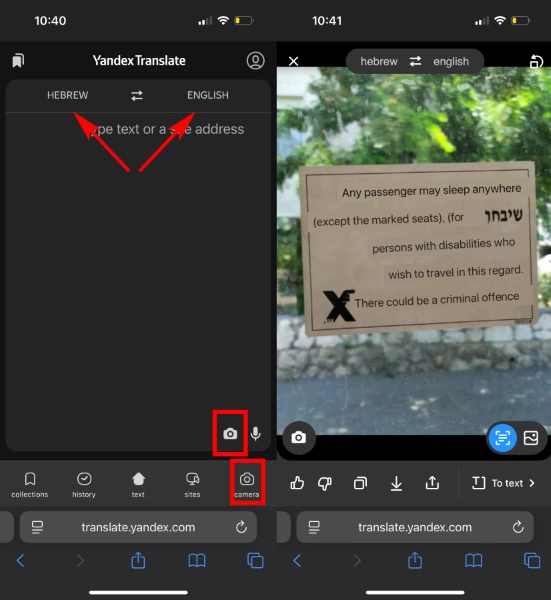
Translation of a sign at a bus stop in Hebrew using Yandex Translate
PROMT uses its own algorithms to recognise text in photos, so you will need to download the OCR module for the required language before using it for the first time. However, the app will then be able to work offline if you have a premium subscription (in free mode, images can only be translated when connected to the internet).
The interface is quite familiar: tap the camera icon, photograph the text or select a file from your gallery, then circle the desired text fragment on the screen to get its translation.

Translation of a sign at a bus stop in Hebrew using PROMT.One
PROMT.One is valued for its additional features: you can select the subject matter of the text (e.g., “IT,” “medicine”) to get a more accurate translation that takes terminology into account. The app also contains a built-in dictionary, allows you to listen to the pronunciation of words, and stores your translation history.
There are no restrictions on photo size – the phone can easily handle standard JPEG photos from a camera. Basic functionality is available for free; a paid subscription is only required for offline mode and advanced features.
Thus, PROMT.One is not just a free online Hebrew photo translator, but also a reliable tool for serious language learning.
Image to Text is an intuitive online service specifically designed for translating text in images. It works through a browser and provides basic functions free of charge.
The service recognises text in photos and immediately displays the translation in the selected language, eliminating the need to copy and paste text manually.
If you need to process large files, there is a paid subscription (extends the limit to ~10 MB and disables ads), but most users will find the free features sufficient.
The process is very simple: select a language pair (from Hebrew to Russian), upload a photo with text, and in a couple of seconds you will receive either the translated text or even an image with the translation superimposed on it.
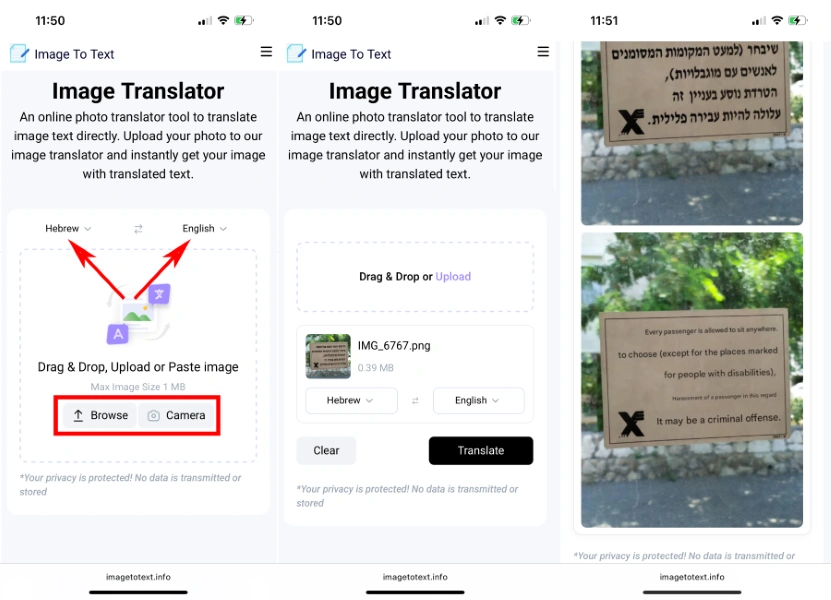
Translate the sign at the bus stop in Hebrew using Image to Text
Recognition accuracy is high for printed Hebrew, although the service is unlikely to cope with handwritten text.
If you need to extract text from an image and are prepared to translate it separately, the Img2Text service will be useful. This is an online translator from Hebrew to English based on photos in a broad sense: it performs OCR (optical character recognition) and provides you with the source text, which can then be translated using any translator.
The advantage of Img2Text is its simplicity and lack of restrictions. The website img2txt.com doesn’t require registration and recognises an unlimited number of images free of charge.
You can take a photo of the page in Hebrew or upload a file from your phone.
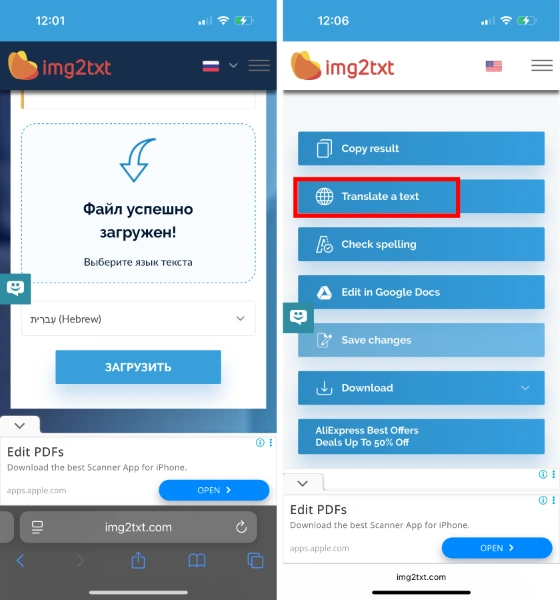
Uploading a photo in Hebrew to Img2Text
Then, you are just one click away from translation: Img2Text will offer to send the recognised text to Google Translate or download the result as a text file.
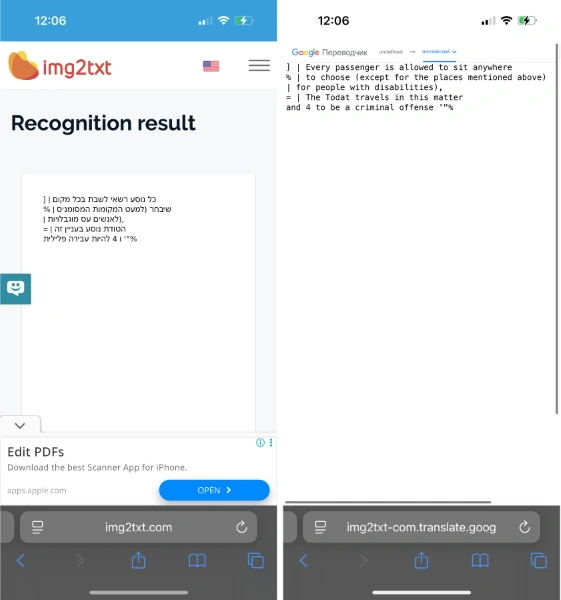
Final translation of the sign at the bus stop in Hebrew using Img2Text
The original language is determined automatically, although you can manually specify Hebrew for better accuracy. Practice shows that Img2Text copes well with printed Hebrew – the text is readable and without distortion if the image quality is good. Of course, the programme cannot recognise handwritten notes or decorative fonts. However, this tool is ideal for scanning documents or book pages.
Translating text from Hebrew using a photograph is no longer magic, but an everyday tool for travellers and language learners.
We discussed various solutions: from universal giants such as Google and Yandex to specialised OCR services. Each of the translators we looked at is free and convenient in its own way.
Choose the one that suits your needs: Google is good for instant translation of signs on the fly, PROMT.One is good for deep immersion in the language with dictionaries, and Img2Text is good for extracting and translating large texts. With their help, the language barrier in Israel will become a little lower, and you will always know what is written around you.